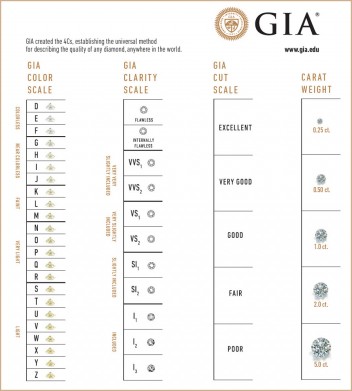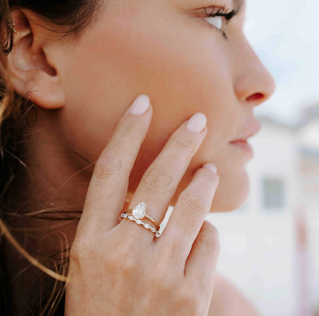6 tips to choose the perfect engagement ring

So, you’re ready to pop the question (and the champagne)? Congratulations! You’re probably high on butterflies now, but you also know that an engagement ring is quite an expense and that you should choose it wisely. Let Laurence help you out!
Read the 6 tips below and find the perfect fit for your significant other.
1. Think about the diamond shape and size
Every shape has a different degree of brilliance and fire, and is priced differently.
The most expensive ones around? The round diamonds, as their cut radiates the most fire and brilliance. Less costly are the pear-, oval- and marquise-shaped varieties (called “fancy shape diamonds”). Is the size of the diamond the most important factor for you? Then be smart: don’t choose the classic round brilliant cut. You’ll get a larger fancy shape diamond for a lower price.
If size matters most, be flexible on other parameters such as color and clarity. If your budget is about 2000 to 3000 euros, you can expect a diamond of about 0.50ct with a reasonable color, clarity and cut grade. If your budget is about 3000 to 4000 euros, you can get a good quality diamond of about 0.70ct.
Before making an appointment for your tailor-made piece of brilliance, take your time to browse through all the different shapes and sizes. More importantly: let your significant other browse and try on some designs. She wouldn’t be the first to change her strong-willed mind once she starts trying different shapes and sizes. Browse through Laurence’s Bridal Collection to find the ring of her dreams.
2. Pay attention to the 4C's
When we talk about diamonds, the first thought that pops up is ‘carats’. But did you know there are other factors determining the diamonds quality too? Meet color, clarity and cut grade. Together with the carat size they are called the 4 C’s. Laurence wrote a very interesting blog post about them. Some people will prefer a larger diamond instead of one with a better color grade. Others will choose a better clarity grade over a larger carat size. You see, the personal question of quality vs. quantity applies here too. But there are a few important things to keep in mind if you want to make the most of your purchase.
When it comes to carat size, here is an important tip to help you save money: choose a less common carat size when available. Diamond prices tend to shoot through the roof when they hit the most desired “magical weights” (0.30, 0.50, 0.70, 1 carat etc.). If available, buy a diamond which is close to these common weights. We guarantee nobody will be able to tell the difference between a 0.91ct diamond and a 1ct one (besides your wallet).
Another tip to save money? Buy a diamond with a color grade that’s not on top of the scale and still looks colorless to the naked eye once set in a ring. For diamonds set in white gold, the most beneficial color grade will be around G or H. With a yellow gold setting, you could even go down to an I or J. The difference in price between an I-color and a D-color is huge.
As for the clarity, choose a clarity grade in the middle of the scale, with a diamond still clean to the naked eye. For example, a diamond may have a SI1 clarity grade and still look impeccable to the naked eye, as the major inclusion is close to the diamond’s girdle and thus easy to cover with a prong in the setting. In diamonds with a clarity grade ranging from VVS to SI, it is actually very unlikely you’d see any inclusions, even with a loupe.
And for the cut grade, always choose the best possible grades: Excellent or Very good. The cut of the diamond gives it that gorgeous sparkle that everyone loves. This important parameter has an enormous influence on the overall brilliance and fire of the stone.

3. Choose the gold color
Traditionally, engagement rings (and wedding bands) are made in 18kt yellow or white gold. Are you looking for a fresher and more modern alternative? Then rose gold might to the trick!
An alternative to white gold is platinum. But it has a greater density and is rarer. So, logically, it’s more expensive as well. Do you wish to explore more about platinum? Check Laurence’s blog post about gold and platinum here.
4. Get her/your finger measured
For him: trying to measure her finger size while she’s asleep might be a bit tricky (and creepy). You know what could help? Laurence’s super handy (pun intended) Ring Size Chart. It will save you a lot of trouble and help you estimate her finger size.
So, you popped the question, but the ring didn’t fit? Breathe: you can have the ring resized. Laurence’s pro tip? It’s always best to choose a bigger size than a smaller one.
For her: browsing through engagement rings, hoping he’d propose anytime soon? Be 100% prepared and have us size your finger in advance. And then? Try to casually mention your size the next time this topic comes up (or tell it to your friends who your boyfriend will probably interrogate).
Shopping for wedding bands? Just pay Laurence a visit together. She’ll professionally and accurately size your finger.

5. Stacking at its best: how will the engagement ring look together with a wedding band
For him: Both the engagement ring and the actual wedding band are important milestones in your relationship. So, choose wisely: while picking your engagement ring, consider a potential stack with the future wedding band. That way, your girl can show off both!
For her: as always, an open conversation is the best. Let your beloved know which style of wedding band you’d prefer to stack with your engagement ring. Some engagement rings don’t allow a band to fit flush against them, so do not hesitate to ask Laurence about the dream combo you have in mind. She will advise you in the best way possible.
Browse through Laurence’s Bridal Collection to find the stack of your dreams
6. Always get a certificate for diamond bigger than 0.30 carat
 By now you know that buying an engagement ring is an expensive (and important!) purchase. Spending your money on crap? That’s the last thing you want! Make sure you get a certificate from a renowned laboratory as the GIA (Gemological Institute of America) or HRD (Hoge Raad voor Diamanten). A diamond grading report, or certificate, is the ID card of a diamond. It’s a thorough description of its quality (4Cs), and thus its value. A diamond certificate assures you that you received the right diamond you paid for. Laurence offers these certificates for every diamond starting from 0.30 carat.
By now you know that buying an engagement ring is an expensive (and important!) purchase. Spending your money on crap? That’s the last thing you want! Make sure you get a certificate from a renowned laboratory as the GIA (Gemological Institute of America) or HRD (Hoge Raad voor Diamanten). A diamond grading report, or certificate, is the ID card of a diamond. It’s a thorough description of its quality (4Cs), and thus its value. A diamond certificate assures you that you received the right diamond you paid for. Laurence offers these certificates for every diamond starting from 0.30 carat.
Did you follow these 6 tips? Congratulations! You’re ready to get married! Tag Laurence in your socials, she’d love to watch your love story unfold!


